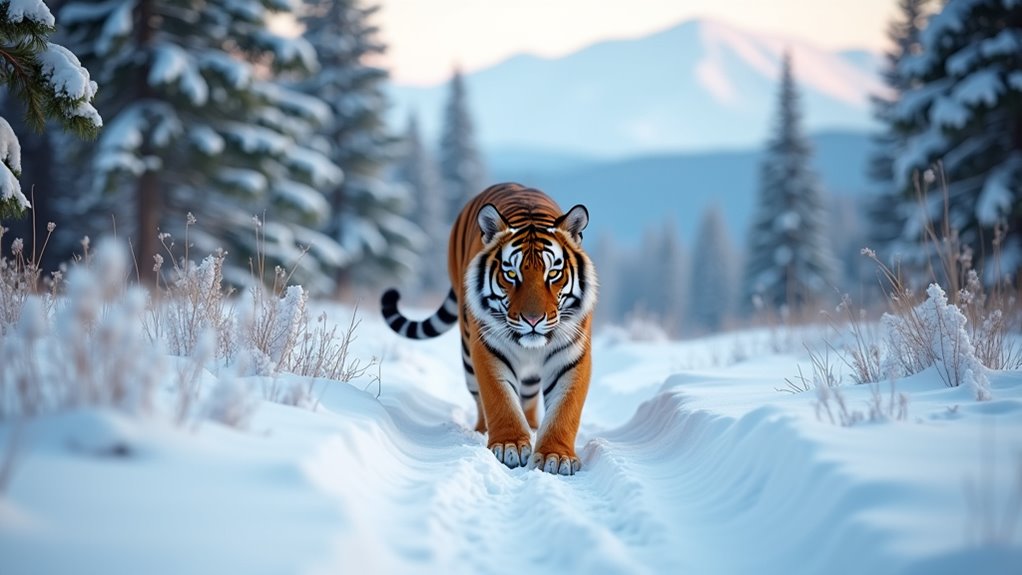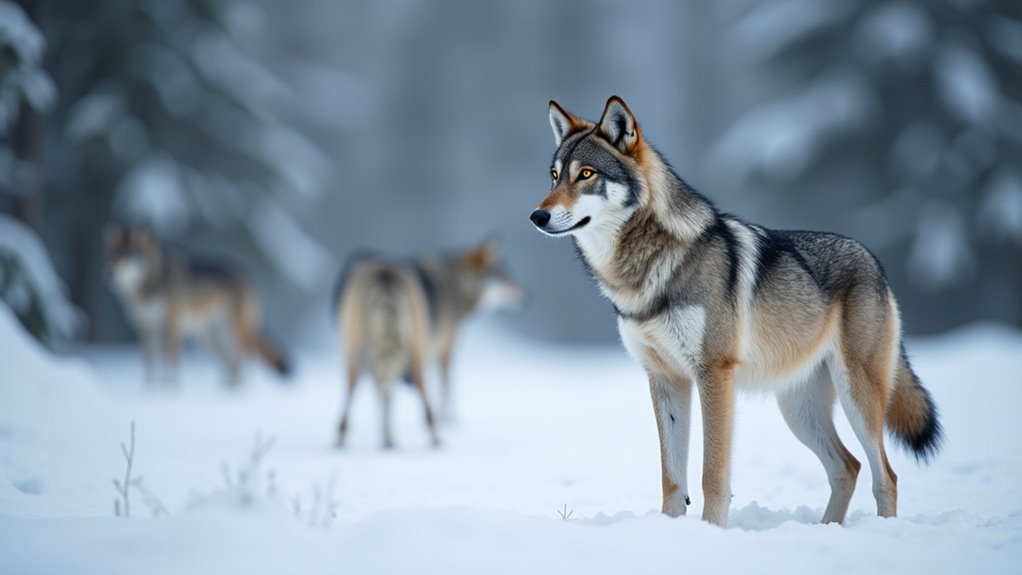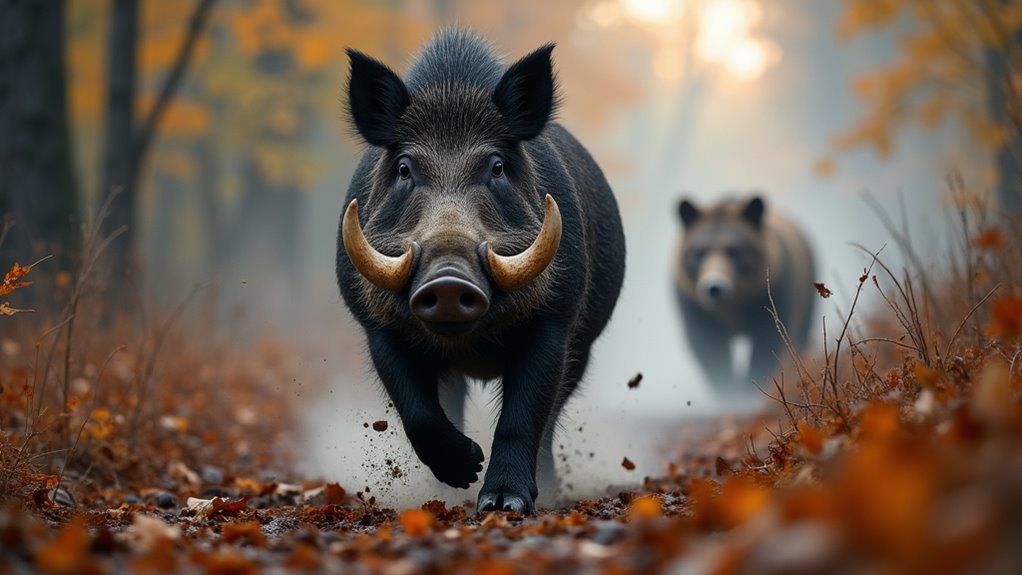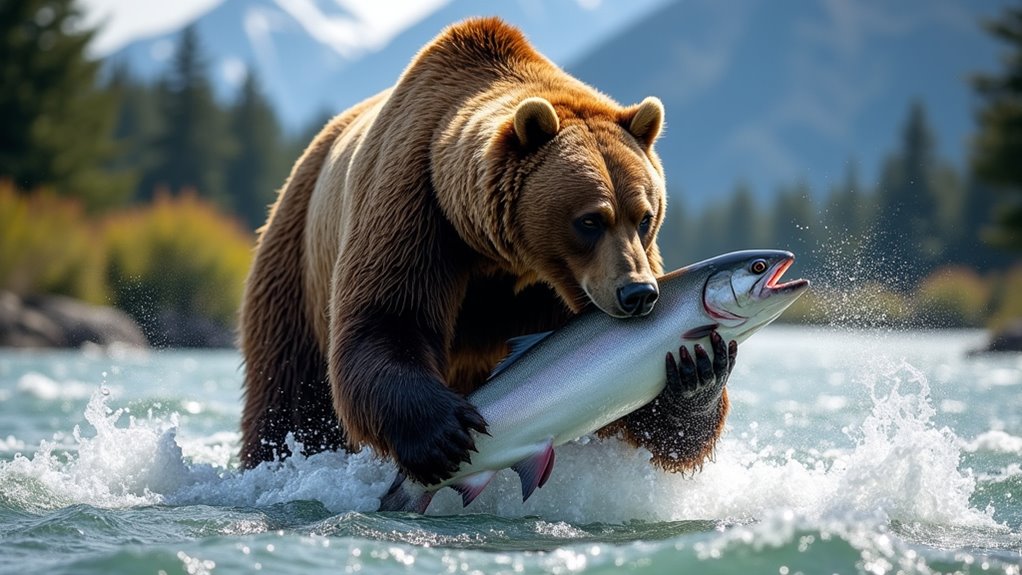Physical Address
304 North Cardinal St.
Dorchester Center, MA 02124
Physical Address
304 North Cardinal St.
Dorchester Center, MA 02124

In Russia's vast wilderness, deadly predators from brown bears to rare Amur tigers lurk in surprising places—but which poses the greatest threat?
Russia’s most dangerous animals include the massive brown bear (120,000+ nationwide), rare Amur tigers (756 in wild), pack-hunting gray wolves, and Arctic polar bears. You’ll also face threats from aggressive wild boars, venomous northern vipers, and the specialized Kamchatka bear. Don’t underestimate smaller dangers like greater weaver fish and disease-carrying taiga ticks. Each creature presents unique risks in Russia’s diverse wilderness, with encounters becoming more likely as habitats change.

Russia’s brown bears reign as the unchallenged apex predators of the nation’s vast forests. With over 120,000 bears nationwide—the world’s largest population—you’ll find these imposing creatures throughout the country, especially in Kamchatka where the beringianus subspecies rivals Kodiak bears in size.
Majestic and mighty, Russia’s 120,000 brown bears dominate its wilderness as the ultimate forest sovereigns.
Males can reach a staggering 481kg with 2.5m body length. Though primarily omnivorous, eating berries, salmon, and nuts, they become dangerous when food-stressed. In 2008, starvation drove 30 bears to kill two humans in a rare mass incident. Beyond Russia, brown bears maintain fragmented populations across Europe, Asia, and North America, with many regions experiencing local extinctions.
While just 1% of encounters lead to attacks, you should take no chances if you spot one.
Trophy hunting attracts wealthy foreigners paying $10,000 per permit, but poaching and habitat loss increasingly threaten these magnificent forest giants.
These magnificent predators are Russia’s most iconic big cats, with fewer than 600 individuals surviving in the wild today. Primarily concentrated in the Sikhote-Alin Mountains, they’re the largest tiger subspecies on Earth, with males exceeding 660 pounds.
Adapted for Russia’s harsh climate, Amur tigers have thick fur, substantial fat layers, and massive paws that allow them to navigate deep snow in temperatures as low as -40°C.
They’re ambush hunters that can take down prey three times their size, requiring up to 35 pounds of meat daily to sustain their massive frames.
While human encounters are rare due to their dwindling numbers and remote habitat, Amur tigers occasionally venture near villages when prey is scarce, creating potentially dangerous situations for livestock and people. Much like avid snorkelers seeking clear waters, these tigers require pristine habitats to survive and thrive. Recent conservation efforts have shown promising results, with population numbers increasing to approximately 756 tigers as of 2022, including about 200 cubs in the Russian Far East.

Spanning across Russia’s diverse landscapes, gray wolves represent one of the country’s most successful pack hunters, with territories extending from European forests to Siberian wilderness.
These highly social predators live in hierarchical packs where the adult male plays a pivotal role in hunting expeditions.
You’ll find them most active during dawn and dusk, targeting wild boar and roe deer in European Russia, while shifting to red deer during snowy periods.
They’re opportunistic, adding moose, European bison, and livestock carrion to their diet when available.
Though wolf hunting is legally practiced through methods like flagging and even helicopter pursuits, these apex predators maintain significant populations.
If you’re traveling in Russia’s wilderness, remember that wolves typically avoid humans but can be dangerous when threatened or hungry.
Wolf home ranges vary dramatically by region, from around 146 km² in European Russia to as much as 832 km² in the Daurian steppe.
Unlike the mountain landscapes near Oslo, Russia’s vast territories provide wolves with extensive hunting grounds and natural corridors for migration.
Dominating the harsh Russian Arctic landscape, polar bears reign as the region’s most formidable apex predators, patrolling nearly 4 million square kilometers from Franz Josef Land to the Bering Strait.
Masters of the frozen wilderness, polar bears command Russia’s Arctic with unrivaled power across its vast northern frontier.
You’ll find these massive hunters primarily on sea ice, where they stalk their favorite prey: ringed and bearded seals.
Russia hosts several key subpopulations, with the Kara Sea region containing the highest proportion of year-round resident bears. Recent research has shown these bears have higher POP levels compared to other Russian Arctic populations.
While encounters are rare, polar bears pose extreme danger to humans. Unlike black or brown bears, they’re true carnivores and view people as potential prey.
They won’t hesitate to stalk and attack if hungry. Climate change has made encounters more frequent as diminishing sea ice forces bears closer to coastal communities.
These magnificent predators have adapted perfectly to Russia’s extremely cold temperatures, surviving in some of the most frigid regions on the planet.
If you’re traveling in Russia’s Arctic regions, always maintain vigilance in polar bear territory.

Wild boars lurking throughout Russia’s forests and grasslands present a far more serious threat than most visitors realize. These formidable creatures can reach 600 pounds and 6 feet in length, armed with tusks up to 5 inches long that can inflict severe lacerations.
You’ll face peak aggression during mating season or when females protect piglets. Their nocturnal habits increase the risk of surprise encounters when you’re hiking in low light. Despite population declines due to African Swine Fever containment efforts (from 338,900 to 286,400 between 2016-2019), they remain numerous and dangerous. In northeastern regions of Russia, particularly in Primorsky Krai and Manchuria, wild boars grow to their most impressive sizes, weighing up to 350 kg and standing significantly taller than their European counterparts. Unlike the tranquil Cyprus resorts that attract travelers for relaxation, Russian forests demand constant vigilance against wildlife threats.
Don’t underestimate their speed and territorial nature. If confronted, seek high ground or a tree to climb, as wild boars can’t easily follow you upward. Never come between a sow and her piglets—this is when attacks are most likely.
While wild boars present an obvious physical threat, Russia’s forests harbor a more subtle danger—the common northern viper. These adders are prevalent in eastern regions toward the Ural Mountains, preferring woodland edges and open countryside.
Though not aggressive, their hemotoxic venom can cause severe pain, swelling, and systemic complications if you’re bitten. The viper’s venom toxicity is relatively low compared to other viper species found globally. Fatalities are rare with prompt medical attention, but you shouldn’t underestimate these reptiles.
You’ll reduce your risk by wearing protective footwear when hiking and staying alert in rocky areas. If you encounter one, give it space—vipers typically flee rather than attack.
They’re actually beneficial predators that control rodent populations.
Despite fear-based persecution, these snakes aren’t endangered, though habitat loss threatens local populations throughout Russia.

Russia’s Kamchatka brown bears stand as the largest and most formidable of Eurasia’s ursine species, with males often exceeding 9 feet when measured. These massive predators develop their impressive size from a salmon-rich diet, though they’ll opportunistically consume berries, insects, and even scavenged marine mammal remains.
You’ll face heightened danger during salmon shortages when these normally solitary giants become increasingly aggressive and territorial. Observers have noted bears traverse snowy wilderness areas shortly after emerging from hibernation, demonstrating their remarkable adaptability to harsh terrain. Unlike their Scandinavian counterparts found in Sweden and Denmark, Kamchatka bears have fewer human interactions and maintain more primitive hunting behaviors. During these periods, bears compete fiercely for prime fishing spots, sometimes resorting to cannibalism. Their aggression spikes dramatically when hyperphagia sets in each fall as they prepare for hibernation.
If traveling in Kamchatka, exercise extreme caution near rivers during spawning season. Climate change and overfishing threaten salmon populations, potentially increasing human-bear conflicts as these apex predators range farther in search of food.
Lurking beneath the sands of Russia’s coastal waters, the greater weaver fish presents an unexpected hazard to beachgoers and fishermen alike. This ambush predator buries itself in sandy substrates with only its eyes and venomous dorsal spine visible, making it nearly impossible to spot.
If you accidentally step on a greater weaver fish, you’ll experience severe pain, swelling, and potential systemic reactions from its potent venom. The excruciating pain can reach 10/10 intensity and may persist for hours to days, sometimes even months. Though rarely lethal, envenomation requires immediate medical attention, including hot water immersion to neutralize the toxin.
During summer months, these fish migrate to shallow spawning grounds, increasing human encounters. While Croatia’s waters are known for travel expenses, Russian coastal areas have their own unique dangers. When visiting Russia’s Black Sea coastline, wear protective footwear and scan the sand carefully. Remember that this nocturnal hunter is most active after dark.

Despite their minuscule size, taiga ticks pose one of Russia’s most serious wildlife threats due to their role as vectors for multiple deadly diseases. These tiny arachnids primarily inhabit Siberia and northern Eurasia, with documented northward expansion due to climate change. A 40-fold increase in tick bite cases has been observed in Sakha from 2000 to 2018, illustrating the growing threat.
When you’re exploring Russia’s forests, particularly during spring and summer, you’re at risk of encountering Ixodes persulcatus and its hybrid relatives. A single bite can transmit tick-borne encephalitis, Lyme disease, babesiosis, or Siberian typhus—sometimes simultaneously. Unlike popular European destinations like Spain or France, Russia requires specific preparation for these unique environmental hazards.
What makes these ticks particularly dangerous is their three-host lifecycle and active questing behavior, combined with limited vaccination options for many of the diseases they carry. If you’re venturing into Russian wilderness, proper protective clothing and regular tick checks are absolutely essential.
When you’re exploring Russia’s wilderness, you’ll face these nine formidable creatures. Remember the 2019 case of Olga Moskalyova, who called her mother while being mauled by a brown bear in Kamchatka. Her tragic story reminds us that nature demands respect, not fear. Pack bear spray, make noise on trails, and research local wildlife before trips. Knowledge and preparedness are your best defense against Russia’s most dangerous animals.